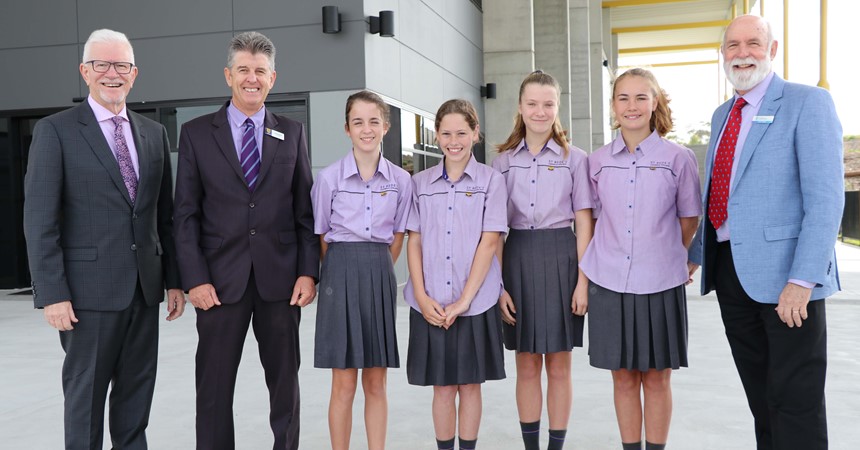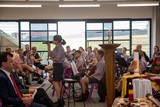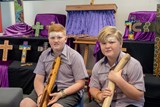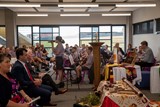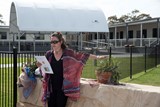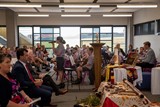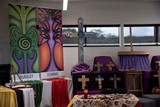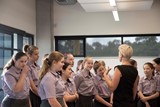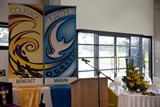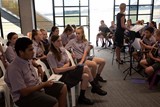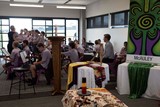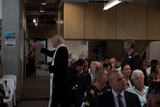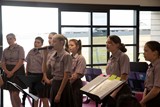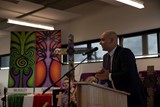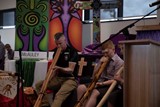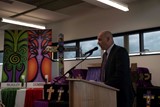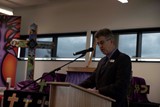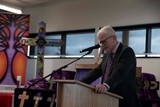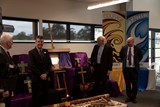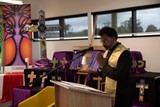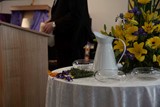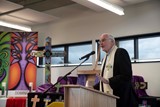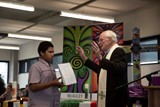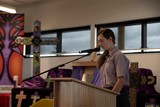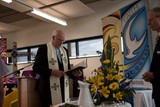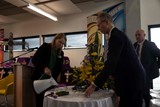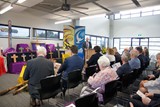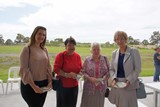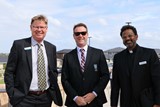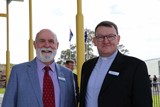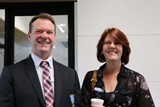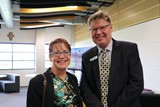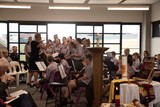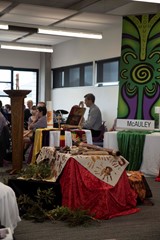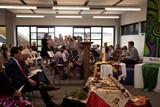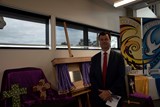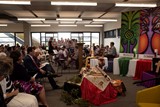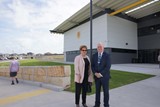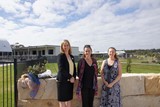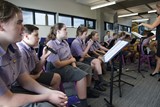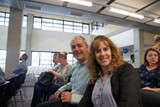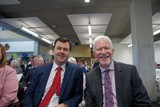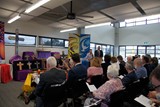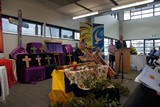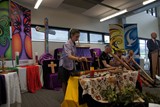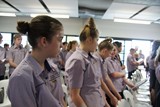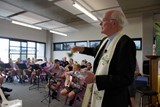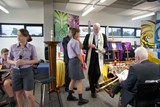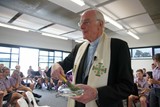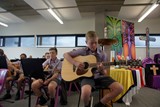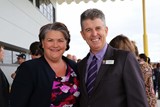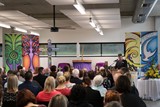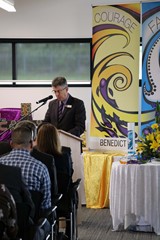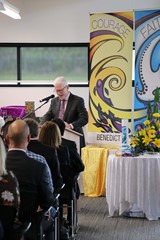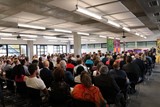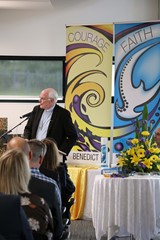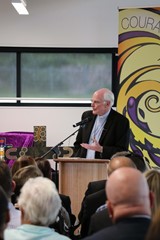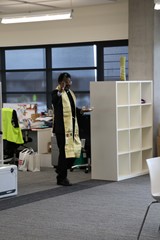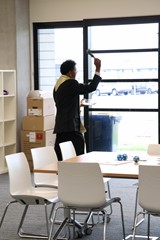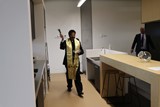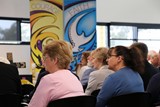The Benedict Building, which will cater for up to 420 students, is the first of four contemporary designed buildings to be completed over the next few years as St Bede’s Catholic College progresses towards becoming a Year 7 – 12 Catholic co-educational school by 2023.
Another three buildings are scheduled for completion between 2020 and 2022. This will allow the school – the first secondary high school to be opened in the Diocese of Maitland-Newcastle since St Paul’s Booragul in 1984 - to accommodate up to 1,200 students.
“The four buildings will each be named after founders of religious orders who have had a marked impact on the religious history and life in our local area,” said Principal John Murphy at the opening.
“These four founders are the patron saints of our student houses: Benedict, Dominic, Marion, and McAuley. The house key values will drive what we do as a College, with each being uniquely associated with these founders.”
The first building will be named Benedict after St Benedict: the founder of the Benedictine order, with courage being the key value.
The second which is due to open at the start of 2021 will be called the Dominic Building, named after St Dominic: the founder of the Dominican sisters, with knowledge being the key value.
The third building which is due to open at the start of 2022 will be called the McAuley Building named after Catherine McAuley: the founder of the Sisters of Mercy that began teaching in the Hunter region in 1875, with community being the key value.
The fourth and final building which is due to open at the start of 2023 will be called the Marian Building: named after Marcellin Champagnat - the founder of the Marist Brothers who began teaching in Maitland in 1898, with faith being the key value.
John Murphy said the school is named after St Bede, an 8th century English religious monk who is regarded as a great theologian and academic writer who has inspired millions.
“St Bede was known for his personal qualities of knowledge, faith, love and justice. He was inspired by the works of St Benedict, a 6th century English monk who is a patron saint of Europe.
“It is fitting therefore that our first building is called the Benedict Building given the close link between St Bede and St Benedict. In utilising these buildings, the challenge for our community will be to achieve the 2023 vision which states: ‘Students will leave St Bede’s Catholic College as confident, resilient and reflective young adults, embracing learning, searching for truth and living their faith in a contemporary world’.”
John Murphy also thanked the Federal Education Minister, Mr. Dan Tehan for the generous capital grant that was received through the Commonwealth Capital Block Grant Authority.
“We all know that investment in education is how we build a stronger and more robust Australian economy and I can assure the Minister that this and any other future capital grants received by St Bede’s will reap enormous benefits as has been evidenced already by what we have achieved in less than one year.”
As Mr Tehan was unable to attend the official opening, John Murphy read out the message the Minister sent to the St Bede’s Community.
“On behalf of the Morrison Government I congratulate St Bede's Catholic College on the opening of your new Benedict Building, which was supported by our Capital Grants Program.
“A good education is critical in giving young people the opportunity to achieve personal success and contribute to our nation.
“Your new high school building represents part of the Coalition's commitment to provide students and teachers with the infrastructure and first-class facilities they need to help learn and equip them to meet future challenges.
“Under the Capital Grants Program, the Australian Government has contributed $3.5 million towards your new Year 7 to Year 12 high school buildings.
“The Australian Government has committed $660 million until 2021 under the Capital Grants Program, to improve capital infrastructure at schools, including $47 million for 53 schools in New South Wales in 2018.
“The Australian Government is committed to ensuring students have the support they need to succeed in the classroom by investing a total of $309.6 billion in recurrent school funding from 2018 to 2029. Recurrent funding will grow from $17.5 billion in 2017 to $31.9 billion in 2029.
“Thank you to the St Bede's Catholic College staff for your efforts and commitment to improving opportunities for your students.
“We look forward to continuing to work with St Bede's Catholic College − the teachers, students, parents and wider school community − so that students have the facilities to succeed in their chosen field of endeavour and reach their full potential.”
Gerard Mowbray, Acting Director for the Catholic Schools Office, said education was now about creating flexible spaces in which students could work creatively and in a team to solve complex problems.
“In the past it was impossible to change the structure of the classroom,” Mr Mowbray said. “But the Benedict Building has been designed to be agile, flexible and adaptive in order to accommodate any significant changes to teaching methods as the years go by.”
According to Gerard Mowbray, one of the most important elements of the design was the linking of the natural environment with the man-made structure and adapting the furniture accordingly.
“The idea is to connect the indoor and outdoor teaching areas and create a range of different learning spaces.”
The need for a new secondary school at Chisholm was identified by the 2013 Study into the Provision of Secondary Education by the Catholic Schools Office in response to rapid population growth in the Maitland Local Government Area.
“New secondary schools are a relative rarity but we are currently going through a significant phase of development in response to a growing school-based population,” Mr Mowbray said.
Elizabeth Brown, Director of SHAC Architects Director, has worked on the St Bede’s design project for the past four years.
She said what was remarkable about the new campus was its complete immersion in providing modern learning spaces, in lieu of the traditional teaching and learning classroom spaces.
“The Catholic Schools Office directive for the design was around the changing teaching pedagogy which is currently being seen across the country, in both public and private education,” she said.
“This changing pedagogy is also known as Future-Focused teaching and learning.”
Elizabeth Brown said the building’s flexible spaces would allow students to work in collaboration zones with the use of furniture and technology to dictate the type of teaching and learning to take place within each area.
“This building is exciting because it is only the first of four stages of works onsite, which we will continue to emphasise the cutting-edge of pedagogy being delivered onsite. The following buildings will provide more specialised teaching spaces, with an internalised circulation spine, known as the Peregrine Trail, which can also be utilised as function teaching spaces. We are thrilled to have been involved in this project, which has had the teaching and education focus, at its heart from the outset."
Interestingly enough, research shows that those educated at a Catholic secondary school are more likely to be employed five years after leaving school than students from other secondary schools.
Longitudinal data from the Australian Bureau of Statistics, which looked at students in Year 11 or Year 12 in 2011 and then tracked what these students were doing in 2016, showed that 76.7 per cent of former Catholic school students were in a job compared with 68.5 per cent for public schools and 71.9 per cent for non-Catholic private schools.

